Camouflage
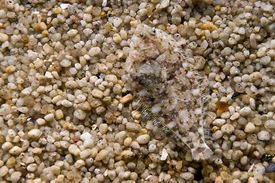

Camouflage is a method of crypsis—avoidance of observation—that allows an otherwise visible organism or object to remain indiscernible from the surrounding environment through deception. Examples include a tiger's stripes, the battledress of a modern soldier and a butterfly camouflaging itself as a leaf. The theory of camouflage covers the various strategies which are used to achieve this effect.
Contents |
In nature
Cryptic coloration is the most common form of camouflage, found to some extent in the majority of species. The simplest way is for an animal to be of a color similar to its surroundings. Examples include the "earth tones" of deer, squirrels, or moles (to match trees or dirt), or the combination of blue skin and white underbelly of sharks via countershading (which makes them difficult to detect from both above and below). More complex patterns can be seen in animals such as flounder, moths, and frogs, among many others.
The type of camouflage a species will develop depends on several factors:
- The environment in which it lives. This is usually the most important factor.
- The physiology and behavior of an animal. Animals with fur need camouflage different from those with feathers or scales. Likewise, animals who live in groups use different camouflage techniques than those that are solitary.
- If the animal is preyed upon then the behavior or characteristics of its predator can influence how the camouflage develops. If the predator has achromatic vision, for example, then the animal will not need to match the color of its surroundings.
Animals produce colors in two ways:
- Biochromes: natural microscopic pigments that absorb certain wavelengths of light and reflect others, creating a visible color that is targeted towards its primary predator.
- Microscopic physical structures, which act like prisms to reflect and scatter light to produce a color that is different from the skin, such as the translucent fur of the Polar Bear, which actually has black skin.
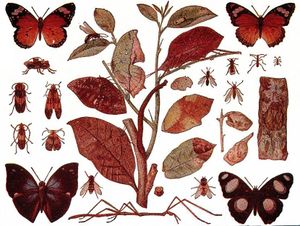
Cryptic coloration can change as well. This can be due to just a changing of the seasons, or it can be in response to more rapid environmental changes. For example, the Arctic fox has a white coat in winter, and a brown coat in summer. Mammals and birds require a new fur coat and new set of feathers respectively, but some animals, such as cuttlefish, have deeper-level pigment cells, called chromatophores, that they can control. Other animals such as certain fish species or the nudibranch can actually change their skin coloration by changing their diet. However, the most well-known creature that changes color, the chameleon, usually does not do so for camouflage purposes, but instead to express its mood.
Beyond colors, skin patterns are often helpful in cryptic coloration as well. The Craik-O'Brien-Cornsweet illusion describes visual perception as occurring through contrasts of outlines. One recognizes a dog, for example, not by its color as much as by its shape. Often what matters most for good cryptic coloration is to break up the outline of a creature's body. This can be seen in common domestic pets such as tabby cats, but striping overall in other animals such as tigers and zebras help them blend into their environment, the jungle and the grasslands respectively. The latter two provide an interesting example, as one's initial impression might be that their coloration does not match their surroundings at all, but tigers' prey are usually color blind to a certain extent such that they cannot tell the difference between orange and green, and zebras' main predators, lions, are color blind. In the case of zebras, the stripes also blend together so that a herd of zebras looks like one large mass, making it difficult for a lion to pick out any individual zebra. This same concept is used by many striped fish species as well. Among birds, the white "chinstraps" of Canada geese make a flock in tall grass appear more like sticks and less like birds' heads.
In nature, there is a strong evolutionary pressure for animals to blend into their environment or conceal their shape; for prey animals to avoid predators and for predators to be able to sneak up on prey. Natural camouflage is one method that animals use to meet these. There are a number of methods of doing so. One is for the animal to blend in with its surroundings, while another is for the animal to disguise itself as something uninteresting or something dangerous.
_W_IMG_0525.jpg)
There is a permanent co-evolution of the sensory abilities of animals for whom it is beneficial to be able to detect the camouflaged animal, and the cryptic characteristics of the concealing species. Different aspects of crypsis and sensory abilities may be more or less pronounced in given predator-prey pairs of species.
Some cryptic animals also simulate natural movement, e.g., of a leaf in the wind. This is called procryptic behaviour or habit. Other animals attach or attract natural materials to their body for concealment. A few animals have chromatic response, changing color in changing environments, either seasonally (ermine, snowshoe hare) or far more rapidly with chromatophores in their integument (the cephalopod family). Some animals, notably in aquatic environments, also take steps to camouflage the odours they create that may attract predators. Some herd animals adopt a similar pattern to make it difficult to distinguish a single animal. Examples include stripes on zebras and the reflective scales on fish.
Gallery
 Hoplophrys oatesii crab hiding in a soft coral from East Timor. |
 An arctic hare's white colouration camouflages it in the snow |
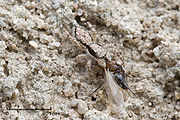 Camouflage allows predator to capture prey |
 The Egyptian Nightjar nests in the open sand with only its colouration to protect it |
|
Scorpion fish resting beside a rope |
A mackerel tabby cat blending with its (autumn) environment |
 Countershaded Ibex are almost invisible in the Israeli desert. |
|
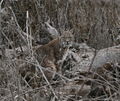 A Bobcat blends with its winter surroundings, at Almaden Quicksilver County Park |
In military

Camouflage was not in wide use in early western civilization based warfare. 18th and 19th century armies tended to use bright colors and bold, impressive designs. These were intended to daunt the enemy, attract recruits, foster unit cohesion, or allow easier identification of units in the fog of war common to the battlefield before the invention of smokeless gun powder. Jäger riflemen in the 18th century were the first to adopt colors in relatively drab shades of green or grey. Major armies retained their bright colors until convinced otherwise. In 1857, the British in India were forced by casualties to dye their white hot-weather uniforms to neutral tones, initially a muddy tan called khaki (from the Urdu word for 'dust'). This was only a temporary measure. It was not until after the Second Boer War that, in 1902, the "home service" (i.e. non-tropical) field uniforms of the entire British army were standardised using a darker shade of khaki serge. Other armies, such as those of the United States, Russia, Italy, and Germany followed suit either with khaki, grey, blue-grey or other colors more suitable for their environments.
Camouflage netting, natural materials, disruptive color patterns, and paint with special infrared, thermal, and radar qualities have also been used on military vehicles, ships, aircraft, installations and buildings. A striking example of this is the dazzle camouflage used on ships during WW I. Ghillie suits are worn by snipers and their spotters to take camouflage to a higher level, combining not just colors, but twigs, leaves and other foliage to break up the human silhouette and to replace the printed patterns of their uniform with colors and materials from their immediate environment so as to remain inconspicuous even while being directly observed through binoculars or from above by aircraft.
A new development are pixelated patterns of so called digital camouflage, like ACUPAT, MARPAT and CADPAT.
Gallery
 British soldier during Operation Granby |
 APC painted with a camouflaging pattern |
 A naval ship camouflaged to reduce visibility at sea |
 A patrol in winter camouflage during the Battle of the Bulge |
 A camouflaged helicopter |
 German flecktarn camouflage pattern |
A soldier applies camouflaging face paint |
 A modern example of desert camouflage |
Non-military applications

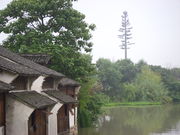
Hunters often use camouflage clothing that is visually tailored to the game they are hunting. The most striking example of this is the blaze orange camouflage, which makes the hunter obvious to humans but relies on the fact that most large game animals, such as deer, are dichromats, and perceive the orange as a dull color. On the other hand, ultraviolet dyes, commonly used in laundry detergents to make the laundered items appear brighter, are visible to many game animals; using these will cause what appears to the human eye to be cryptically colored clothing to stand out against the background, when viewed by an animal with ultraviolet-sensitive eyes.[1]
There are several different types of hunting camouflage. The use of each one is dependent upon the area in which the hunter is going to hunt. It can range in appearance from a mossy oak pattern to a sage brush pattern for hunters of large mammals. Waterfowl hunters can have camouflage that resembles swamp reeds.
See also
- Active camouflage
- Animal coloration
- Aposematism
- Everett Warner
- Motion camouflage
- Underwater camouflage and mimicry
References
Notes
Bibliography
- Roy R. Behrens - Art and Camouflage: An Annotated Bibliography
- Behrens, Roy R. (2009). CAMOUPEDIA: A Compendium of Research on Art, Architecture and Camouflage. Bobolink Books. ISBN 978-0-9713244-6-6.
- Behrens, Roy R. (2009), "Camouflage" in E. Bruce Goldstein, ed., Encyclopedia of Perception. Sage Publications, pp. 233–236. ISBN 978-1-4129408-1-8.
- Behrens, Roy R. (2002). FALSE COLORS: Art, Design and Modern Camouflage. Bobolink Books. ISBN 0-9713244-0-9.
- Goodden, Henrietta (2007). Camouflage and Art: Design for Deception in World War 2. Unicorn Press. ISBN 978-0-906290-87-3.
- Harris, Tom. "How Animal Camouflage Works". How Stuff Works. http://science.howstuffworks.com/animal-camouflage2.htm. Retrieved 2006-11-13.
- "How do a zebra's stripes act as camouflage?". How Stuff Works. http://science.howstuffworks.com/question454.htm. Retrieved 2006-11-13.
- Newark, Tim (2007). Camouflage. Thames and Hudson, and Imperial War Museum. ISBN 978-0-500-51347-7.
- Jon Latimer, Deception in War, London: John Murray, 2001.
- Traver, Kacey. Life under the Sea.' Copyright 2008.
- Everett L. Warner, “The Science of Marine Camouflage Design” in Transactions of the Illuminating Engineering Society 14 (5) 1919, pp. 215–219.
- Everett L. Warner, “Fooling the Iron Fish: The Inside Story of Marine Camouflage” in Everybody’s Magazine (November 1919), pp. 102–109.
External links
- Artists and Other Contributors to Camouflage in the 20th Century
- Roy R. Behrens, "The Thinking Eye: a Chronology of Camouflage" 2006
- "An informal study into camouflage"
|
||||||||